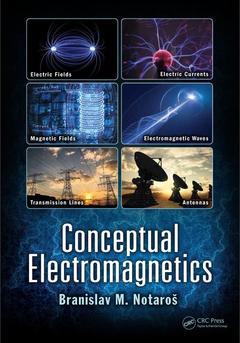Description
Conceptual Electromagnetics
Language: English
Subjects for Conceptual Electromagnetics:
Keywords
Electric Field Intensity Vector; electrostatic field; Field Intensity Vector; electric currents; Magnetic Field Intensity Vectors; magnostatic field; PEC; free space; Uniform Plane Wave; time-varying; Lossless Transmission Line; transmission of plane waves; Lossless Coaxial Cable; Electric Field Intensity; Magnetic Flux Density Vector; TEM Wave; PEC Ground Plane; Homogeneous Dielectric; PEC Plane; Steady Current; Complex Rms Electric Field Intensity; Uniform Plane; Complex Rms; Hertzian Dipole; Magnetic Flux Density; Poynting Vector; Wire Dipole; Rectangular Metallic Waveguide; Effective Relative Permittivity; Rms Electric Field Intensity; Half Wave Dipole
· 17.8x25.4 cm · Hardback
Description
/li>Contents
/li>Biography
/li>
This is a textbook on electromagnetic fields and waves completely based on conceptual understanding of electromagnetics. The text provides operational knowledge and firm grasp of electromagnetic fundamentals aimed toward practical engineering applications by combining fundamental theory and a unique and comprehensive collection of as many as 888 conceptual questions and problems in electromagnetics. Conceptual questions are designed to strongly enforce and enhance both the theoretical concepts and understanding and problem-solving techniques and skills in electromagnetics.
1 Electrostatic Field in Free Space. 1.1 Coulomb’s Law. 1.2 Electric Field Intensity Vector Due to Given Charge Distributions. 1.3 Electric Scalar Potential. 1.4 Differential Relationship Between the Field and Potential in Electrostatics, Gradient. 1.5 Gauss’ Law in Integral Form. 1.6 Differential Form of Gauss’ Law, Divergence. 1.7 Conductors in the Electrostatic Field. 1.8 Electrostatic Shielding 1.9 Charge Distribution on Metallic Bodies of Arbitrary Shapes. 1.10 Image Theory..2 Electrostatic Field in Dielectrics. 2.1 Polarization of Dielectrics. 2.2 Generalized Gauss’ Law and Permittivity.2.3 Dielectric–ielectric Boundary Conditions. 2.4 Analysis of Capacitors with Homogeneous Dielectrics.2.5 Analysis of Capacitors with Inhomogeneous Dielectrics. 2.6 Energy of an Electrostatic System.2.7 Dielectric Breakdown in Electrostatic Systems. 3 Steady Electric Currents. 3.1 Continuity Equation, Conductivity, and Ohm’s and Joule’s Laws in Local.Form. 3.2 Resistance, Conductance, and Ohm’s Law. 3.3 Boundary Conditions for Steady Currents. 3.4 Duality Relationships in the Steady Current Field. 3.5 Lossy Transmission Lines with Steady Currents. 4 Magnetostatic Field in Free Space. 4.1 Magnetic Force and Magnetic Flux Density Vector. 4.2 Biot-Savart Law. 4.3 Amp`ere’s Law in Integral Form. 4.4 Differential Form of Amp`ere’s Law, Curl. 4.5 Law of Conservation of Magnetic Flux. 4.6 Magnetic Vector Potential. 5 Magnetostatic Field in Material Media 5.1 Magnetization Current. 5.2 Generalized Amp`ere’s Law and Permeability. 5.3 Boundary Conditions for the Magnetic Field. 5.4 Image Theory for the Magnetic Field. 5.5 Magnetization Curves and Hysteresis. 5.6 Magnetic Circuits. 5.7 Magnetic Energy. 6 Time-Varying Electromagnetic Field. 6.1 Induced Electric Field Intensity Vector. 6.2 Faraday’s Law of Electromagnetic Induction. 6.3 Electromagnetic Induction Due to Motion and Total Induction. 6.4 Self-Inductance. 6.5 Mutual Inductance. 6.6 Displacement Current. 6.7 Maxwell’s Equations for the High-Frequency Electromagnetic Field. 6.8 Boundary Conditions for the High-Frequency Electromagnetic Field. 6.9 Time-Harmonic Electromagnetics. 6.10 Complex Representatives of Time-Harmonic Field and Circuit Quantities. 6.11 Lorenz Electromagnetic Potentials. 6.12 Instantaneous and Complex Poynting Vector, Poynting’s Theorem. 7 Uniform Plane Electromagnetic Waves. 7.1 Wave Equations. 7.2 Time-Domain Analysis of Uniform Plane Waves. 7.3 Time-Harmonic Uniform Plane Waves and Complex-Domain Analysis. 7.4 Arbitrarily Directed Uniform Plane Waves. 7.5 Theory of Time-Harmonic Waves in Lossy Media. 7.6 Good Dielectrics and Good Conductors. 7.7 Skin Effect. 7.8 Wave Propagation in Plasmas. 7.9 Dispersion and Group Velocity. 7.10 Polarization of Electromagnetic Waves. 8 Reflection and Transmission of Plane Waves. 8.1 Normal Incidence on a Perfectly Conducting Plane. 8.2 Normal Incidence on a Penetrable Planar Interface. 8.3 Oblique Incidence on a Perfect Conductor. 8.4 Oblique Incidence on a Dielectric Boundary. 9 Field Analysis of Transmission Lines. 9.1 Field Analysis of Lossless Transmission Lines. 9.2 Transmission Lines With Small Losses. 9.3 Evaluation of Primary and Secondary Circuit Parameters of Transmission. Lines. 9.4 Transmission Lines With Inhomogeneous Dielectrics. 10 Circuit Analysis of Transmission Lines. 10.1 Telegrapher’s Equations and Their Solution. 10.2 Reflection Coefficient for Transmission Lines. 10.3 Transmission-Line Impedance. 10.4 Short-Circuited, Open-Circuited, and Matched Transmission Lines. 10.5 The Smith Chart. 10.6 Transient Analysis of Transmission Lines with Step Excitations. 10.7 Analysis of Transmission.
Branislav M. Notaroš is a professor in the Department of Electrical and Computer Engineering at Colorado State University, where he also is director of the Electromagnetics Laboratory. He received a Ph.D. in electrical engineering from the University of Belgrade,Yugoslavia, in 1995. His research publications in computational and applied electromagnetics include more than 150 journal andconference papers. He is the author of textbooks Electromagnetics (2010) and MATLAB-Based Electromagnetics (2013), both with Pearson Prentice Hall. Prof. Notaroš served as general chair of FEM2012, Colorado, USA, and as guest editor of the “Special Issue on Finite Elements for Microwave Engineering,” in Electromagnetics, 2014. He was the recipient of the 1999 Institution of Electrical Engineers (IEE) Marconi Premium, 2005 Institute of Electrical and Electronics Engineers (IEEE) MTT-S Microwave Prize, 2005 UMass Dartmouth Scholar of the Year Award, 2012 Colorado State University System Board of Governors Excellence in Undergraduate Teaching Award, 2012 IEEE Region 5 Outstanding Engineering Educator Award, 2014 Carnegie Foundation for the Advancement of aching Colorado Professor of the Year Award, 2015 American Society for Engineering Education ECE Distinguished Educator Award, 2015 IEEE Undergraduate Teaching Award, and many other research and teaching awards.




